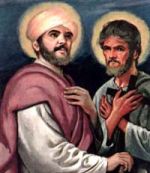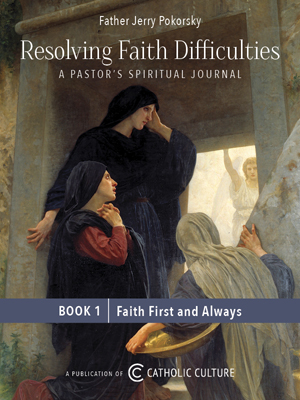College of Cardinals Traces Its Roots to Middle Ages
The college of cardinals is known for its power, but it hasn't been a part of the Church since the earliest days of Christianity.
Its members—the "princes of the Church"—now serve as papal advisers, head the major congregations in the Vatican and run the largest of the world's archdioceses. Perhaps most visibly, they gather at the death of a pope to elect his successor in a formal, somber and secretive assembly called the conclave.
But unlike the roles of bishops, priests and deacons, the college is a later development that only reached the fullness of its stature and authority during the high Middle Ages. It was part of the growth of a papal monarchy that fought with secular emperors in an attempt to maintain the Church's independence.
With no basis in Scripture—the usual Church authority for the Middle Ages the college of cardinals grew not from a fairly precise function grounded in the apostolic Church, as did the bishops, but instead evolved from tradition. It was generally accepted, but not canonically asserted, that the cardinals were successors to the original apostles.
During the early Middle Ages, cardinalis referred to the deacons and priests of the 25 to 30 tituli (parishes within Rome) and the bishops immediately surrounding the city in seven suburban sees. These clerics assisted the pope in various liturgical tasks about once a week.
This special function led to an increase of stature for these particular deacons, priests and bishops, sometimes known collectively, with the pope, as the "Roman Church."
Another precedent for the cardinals was the powerful metaphor of the Roman Senate, which may have been the model for the college. In any case, it was a group that increasingly assumed a major, substantive role in ecclesiastical affairs with the institutional reforms put into place by Pope Gregory VII (1073-1085).
Cardinals were used by popes seeking to extend the papal authority. They served as a regular body of counselors, legates (official representatives) and curial officials, often taking advantage of these new roles and using the occasions of a weak pope to strengthen their own power.
So strong was the ascendance of collegial authority that one modern scholar, invoking two of the most important Latin phrases for collegial evolution, declared without qualification that the sacred college was pars corporis papae—part of the body of the papacy—and exercised with the pope his plena potestas—the fullness of his powers.
From the mid-11th century, cardinals took on added importance: their liturgical functions were displaced by new institutional tasks as a result of the Gregorian reform. This had actually begun under Pope Leo IX (1049-1054), when ecclesiastical organization became more centralized and the European Church was brought under strong, direct papal control. As institutional apparatuses expanded, so did the need for qualified personnel to oversee papal business.
In modern terms, as the home-office bureaucracy grew, more upper-management personnel were needed.
Pope Paschal II (1099-1118), in particular, appointed cardinals as legates and put others in charge of curial departments.
The college grew: the 16 popes who served from 1099 to 1198 appointed about 300 cardinals, while close to another 140 were named in the following century. Pope Sixtus V (1585-1590) limited the number of cardinals to 70, but rarely were there that many in office at any one time.
As the cardinal clergy were separated from their liturgical ties to Rome, some geographical diversity was introduced, especially as the popes sought to strengthen their international jurisdiction. St. Bernard of Clairvaux (1090-1153), writing to his pupil and fellow Cistercian Pope Eugenius III (1145-1153), urged him to cast his net wide for cardinals, since their decisions would affect all of Christendom.
Germans were almost never made cardinals because of the papacy's continuing conflicts with the Holy Roman emperors. French cardinals outnumbered their Italian colleagues during the papacy's years in the French city of Avignon (1305-1378). The seven popes at Avignon created 134 cardinals: only 14 were Italian, but 95 were Frenchmen.
By the High Middle Ages, cardinal-deacons, -priests and -bishops had evolved into a sort of papal cabinet, participating in the business of the Church as full members of the larger body of the papacy. There was much historical precedent for such participation in the Church. Monastic life stood as an example. Benedict of Nursia, in his sixth-century "Rule," stipulated that if some important action concerning an entire monastic community must be taken, the abbot should convene his monks. Although the final decision rested with the abbot, the monks should deliberate to render their judgment to him.
Pope Urban II (1088-1099), the Frenchman Eudes de Lagery, adopted as models procedures from Church and state: regulations from Cluniac monasteries and the administrative bureaucracy of the royal Capetian house's feudal holdings. In doing so, Urban fashioned his curia after royal courts, using gatherings of his cardinals in a manner similar to the way French and English monarchs employed the king's council.
But increased participation didn't make for easy collaboration. The radical notion of full democratic participation in Church matters was obviously untenable, but to some so was the idea of papal autocracy. A middle ground was needed. Hostiensis (Henry of Susa, c.1200-1271)—a Bolognese-trained canon lawyer who became cardinal-archbishop of Ostia (southwest of Rome) and turned his attention to the college of cardinals—believed that prelates sitting between the "highest" and "lowest" layers of the Christian faithful could operate in something of a mediatory way. This role fell to the cardinals, who enjoyed an especially close relationship with the pope.
Modern scholarship is split on the matter of whether Hostiensis believed the pope could act only with the consent of his cardinals. Nevertheless, it's clear that he held the relationship between a pope and his college of cardinals to be so close that each ought to consult with the other, for consultation among many renders better judgment, as is the case with an abbot and his monks or a bishop and the canons of his cathedral.
Popes frequently mentioned in their decrees that an opinion or judgment was rendered "de fratrum nostrum consilio" —with the advice of our brothers." Cardinals signed papal decrees and privileges as witnesses, evidence of their heightened stature.
The consistory of cardinals began to replace intermittent synods of bishops as a more regularized arena for discussing important matters and rendering valuable advice.
This was possible in part because a cadre of capable cardinals (better-educated by the rise of universities and growing expertise in law and theology) had become a constant presence in the Roman Curia.
In Rome, the consolidation and expansion of papal authority had rapidly necessitated the development of a trained bureaucracy to handle papal business.
The camera was the office handling financial matters, the camerarius oversaw papal finances, and the cancellaria was the secretariat that kept track of the massive, steady work of recording and disseminating papal appointments, court decisions, relationships with religious orders, political negotiations and ordinary correspondence.
Each department, along with certain other lesser offices, came to be headed by a cardinal. The chancellor, cancellarius, was especially powerful: four chancellors were elected pope in the 12th century.
After the pontificate of Gregory VII, more cardinals were selected as papal legates, conducting the pope's business away from Rome, They were sometimes expressly allowed to act in his name with full papal authority. Some cardinal-legates were called "papal vicars" in documents and were authorized to wear papal insignia and robes.
In our own time, Pope John Paul II has at times swelled the college to more than 160 members. He has also named cardinals in every part of the globe, a process begun in earnest by Pope Paul VI (1963-1978).
New cardinals have notably been created in nations where Catholicism is enjoying enthusiastic growth, including countries in Africa, southeast Asia, Eastern Europe and Latin America. Since John Paul II has appointed a majority of the 120 "elector cardinals"—those who choose a pontiff—it is likely the next pope will be cast in a similar image to the first non-Italian cardinal elected pope in more than four-and-a-half centuries.
Christopher M. Bellitto is an assistant professor of Church history at the Institute of Religious Studies and St. Joseph's Seminary, Dunwoodie, in Yonkers, N. Y
(Catholic Heritage, 200 Noll Plaza, Huntington, IN 46750)
This item 340 digitally provided courtesy of CatholicCulture.org






